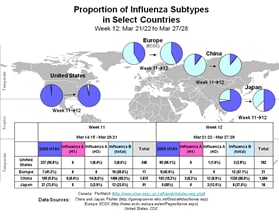You are subscribed to updates from the Centers for Disease Control and Prevention (CDC).
CDC H1N1 Flu Website Situation Update, April 9, 2010
Key Flu Indicators
Each week CDC analyzes information about influenza disease activity in the United States and publishes findings of key flu indicators in a report called FluView. During the week of March 28-April 3, 2010, nationally most key flu indicators declined slightly from the previous week. Overall, influenza activity is low in the United States. Below is a summary of the most recent key indicators:
- Visits to doctors for influenza-like illness (ILI) declined from last week and are low nationally with all 10 U.S. regions seeing declining or stable ILI. (Last week, Region 9 -- the Southwest and Hawaii -- had elevated ILI.)
- Laboratory-confirmed hospitalizations rates have leveled off and very few hospitalizations were reported by states during the week ending April 3; however, in recent prior weeks, some states – mostly in the Southeast of the country – had been reporting increases in the number of flu-related hospitalizations.
- The proportion of deaths attributed to pneumonia and influenza (P&I) based on the 122 Cities Report decreased over last week and is now below baseline. One flu-related pediatric death was reported this week associated with an unsubtyped influenza A virus. Since April 2009, CDC has received reports of 334 laboratory-confirmed pediatric deaths: 280 due to 2009 H1N1, 52 pediatric deaths that were laboratory confirmed as influenza A, but the flu virus subtype was not determined, and two pediatric deaths that were associated with seasonal influenza viruses. (Laboratory-confirmed deaths are thought to represent an undercount of the actual number. CDC has provided estimates about the number of 2009 H1N1 cases and related hospitalizations and deaths).
- No states reported widespread influenza activity. Three states continue to report regional influenza activity. They are: Alabama, Georgia and South Carolina. Local and regional flu activity has been sustained in most of the Southeast over the past several weeks.
- The majority of the influenza viruses identified so far continue to be 2009 H1N1 influenza A viruses. These viruses remain similar to the virus chosen for the 2009 H1N1 vaccine and remain susceptible to the antiviral drugs oseltamivir and zanamivir with rare exception.
*All data are preliminary and may change as more reports are received.
U.S. Situation Update
U.S. Patient Visits Reported for Influenza-like Illness (ILI)

U.S. Influenza-like Illness (ILI) Reported by Regions

|
Cases Defined by
|
Hospitalizations
|
Deaths
|
|
|---|---|---|---|
| Influenza Laboratory-Tests** | 41,821 | 2,117 | |
|
*Reports can be based on syndromic, admission or discharge data, or a combination of data elements that could include laboratory-confirmed and influenza-like illness hospitalizations. *Laboratory confirmation includes any positive influenza test (rapid influenza tests, RT-PCR, DFA, IFA, or culture), whether or not typing was done. The table shows aggregate reports of all laboratory confirmed influenza hospitalizations and deaths (including 2009 H1N1 and seasonal flu) since August 30, 2009 received by CDC from U.S. states and territories**. This table will be updated weekly each Friday at 11 a.m. For the 2009-2010 influenza season, states are reporting based on new case definitions for hospitalizations and deaths effective August 30, 2009. CDC will continue to use its traditional surveillance systems to track the progress of the 2009-2010 influenza season. For more information about influenza surveillance, including reporting of influenza-associated hospitalizations and deaths, see Questions and Answers: Monitoring Influenza Activity, Including 2009 H1N1. The number of 2009 H1N1 hospitalizations and deaths reported to CDC from April – August 2009 is available on the Past Situation Updates page. For state level information, refer to state health departments. International Human Cases of 2009 H1N1 Flu Infection
**States report weekly to CDC either 1) laboratory-confirmed influenza hospitalizations and deaths or 2) pneumonia and influenza syndrome-based cases of hospitalization and death resulting from all types or subtypes of influenza. Although only the laboratory confirmed cases are included in this report, CDC continues to analyze data both from laboratory confirmed and syndromic hospitalizations and deaths. |
|||
|
Date Reported
|
Laboratory-Confirmed 2009 H1N1 Influenza Pediatric Deaths
|
Laboratory-Confirmed Influenza A Subtype Unknown Pediatric Deaths
|
Laboratory-Confirmed
Seasonal Influenza |
Total |
|---|---|---|---|---|
| This Week (Week 13, March 28 - April 3, 2010) | 0 | 1 | 0 | 1 |
| Since August 30, 2009 | 220 | 49 | 1 | 270 |
| Cumulative since April 26, 2009 | 280 | 52 | 2 | 334 |
|
This table is based on data reported to CDC through the Influenza-Associated Pediatric Mortality Surveillance System. Influenza-associated deaths in children (persons less than 18 years) was added as nationally notifiable condition in 2004. For more information about influenza-associated pediatric mortality, see FluView. |
||||
For more information about the U.S. situation, see the CDC H1N1 Flu U.S. Situation page.
International Situation Update
This report provides an update to the international flu situation using data collected through April 4, 2010, and reported by the World Health Organization (WHO) on April 9. WHO continues to report laboratory-confirmed 2009 H1N1 flu cases and deaths on its Web page. These laboratory-confirmed cases represent a substantial underestimation of total cases in the world, as most countries focus surveillance and laboratory testing only on people with severe illness.
Currently, 2009 H1N1 flu activity is highest in parts of Southeast Asia, West Africa, and the tropical regions of the Americas. In the temperate areas of the Northern and Southern Hemisphere, 2009 H1N1 virus continues to circulate at low levels. Seasonal influenza B viruses continue to circulate in East Asia and have been detected at low levels across parts of Asia and Europe. Seasonal influenza A (H3N2) viruses continue to be reported occasionally across Asia, Africa, Australia, and the Americas. However, the highest H3N2 virus activity has been reported in Indonesia.
For more information about the international situation, see the CDC H1N1 Flu International Situation page.
Recent Updates of Interest
- UPDATE: 2009 H1N1 Flu International Situation Update
This report provides an update to the international situation as of April 9, 2010. The World Health Organization (WHO) continues to report updated 2009 H1N1 flu-associated laboratory-confirmed cases and deaths on its Web page. - UPDATE: Weekly FluView Map and Surveillance Report for Week Ending April 3, 2010
During week 13 (March 28-April 3, 2010), influenza activity decreased slightly in the U.S. 105 (3.7%) specimens tested by U.S. World Health Organization (WHO) and National Respiratory and Enteric Virus Surveillance System (NREVSS) collaborating laboratories and reported to CDC/Influenza Division were positive for influenza. - UPDATE: Influenza and Pneumonia-Associated Hospitalizations and Deaths from August 30, 2009 to April 3, 2010
Flu activity in the United States declined slightly from last week and is low nationally; however, some states in the Southeast continue to report regional activity, according to the March 28-April 3, 2010 FluView. Most flu continues to be 2009 H1N1. Flu activity, caused by either 2009 H1N1 or seasonal flu viruses, may rise and fall, but is expected to continue for weeks in the U.S. Internationally, 2009 H1N1 flu is still circulating, including in the Southern Hemisphere, which is about to enter its flu season. For more information, please see the international situation update. - NEW: 5 Things Caregivers of People with Disabilities Need To Know About the Flu
If you provide care for a person with a disability either at home or in a community-based setting, read the 5 Things Caregivers of People with Disabilities Need to Know about the Flu. - NEW: 5 Things People with Disabilities Need To Know About the Flu
If you are a person with a disability, read the 5 Things People with Disabilities Need to know about the Flu. - NEW: Interim Results: State-Specific Influenza A (H1N1) 2009 Monovalent Vaccination Coverage
Morbidity and Mortality Weekly Report (MMWR) April 2, 2010 / 59(12); 363-368. - NEW: Interim Results: Influenza A (H1N1) 2009 Monovalent and Seasonal Influenza Vaccination Coverage Among Health-Care Personnel --- United States, August 2009--January 2010
Morbidity and Mortality Weekly Report (MMWR) April 2, 2010 / 59(12);357-362.
Additional Updates on the CDC H1N1 Flu Website
To learn about other recent updates made to the CDC H1N1 Flu Website, please check the "What's New" page on the CDC H1N1 Flu website.
Get H1N1 Updates & Health Tips via Text Message
 Sign up to get health updates sent via text message. Messages are sent about three times a week with relevant H1N1 flu updates and timely
health tips.
Sign up to get health updates sent via text message. Messages are sent about three times a week with relevant H1N1 flu updates and timely
health tips.
Text UPDATES to 87000 to sign up.
To learn more, see www.cdc.gov/mobile.
Modify/Update Subscriber Preferences | Unsubscribe | Send Feedback | Learn more about CDC Email Updates
To receive the latest news for your region, please update your profile with your country, state and zip code.
Questions or problems? Please contact support@xxxxxxxxxxxxxxx.

|
Fight Flu with Facts! • Visit Flu.gov
|

|
Centers for Disease Control and Prevention (CDC) · 1600 Clifton Rd · Atlanta GA 30333 · 800-CDC-INFO (800-232-4636)


